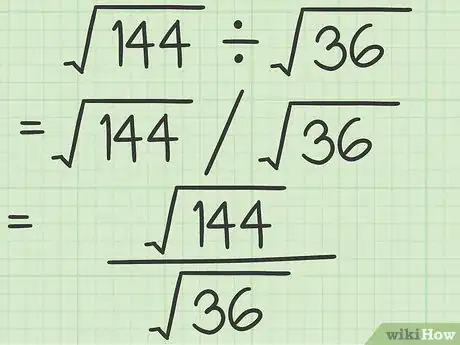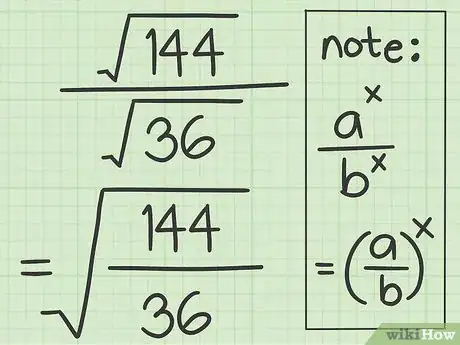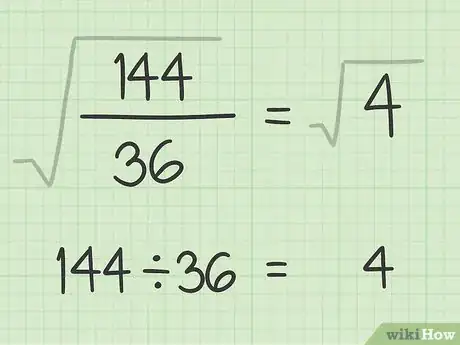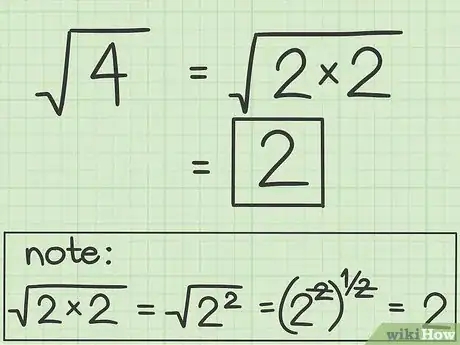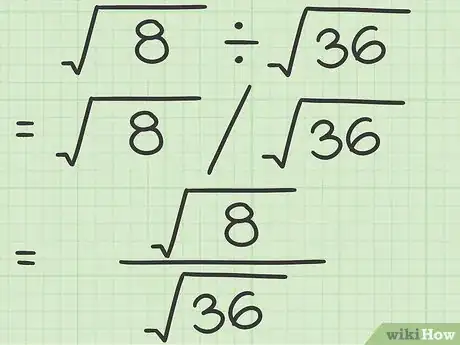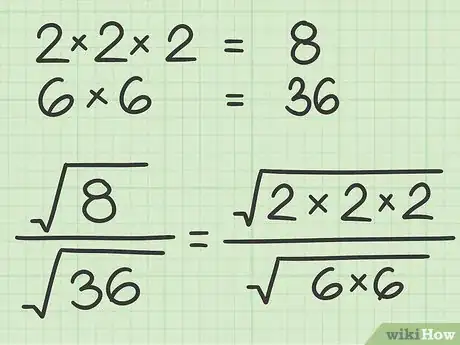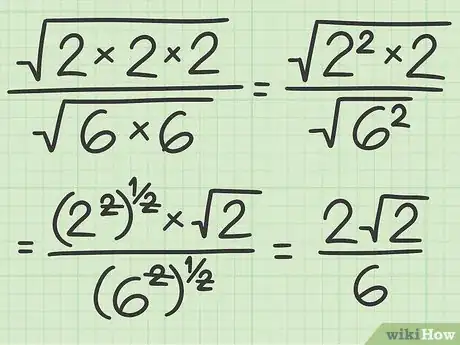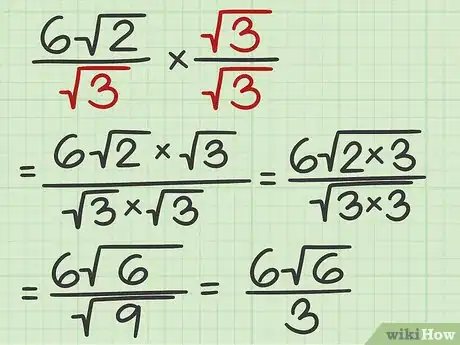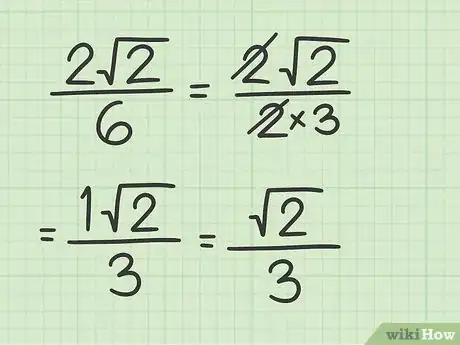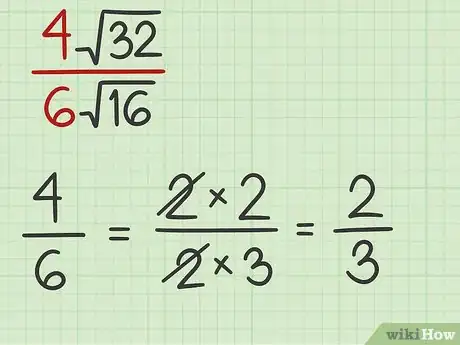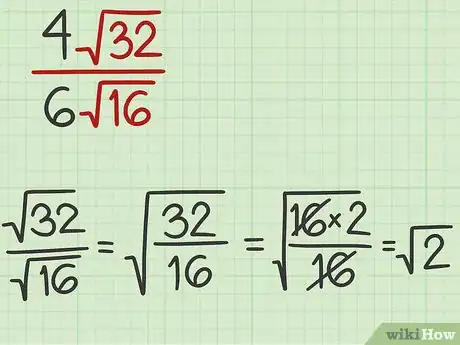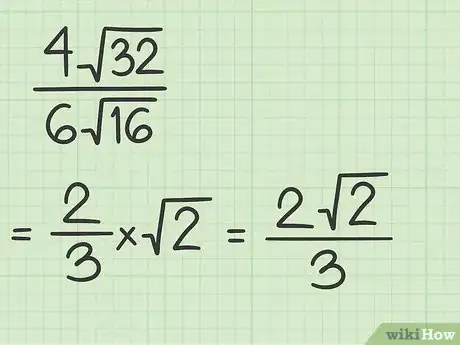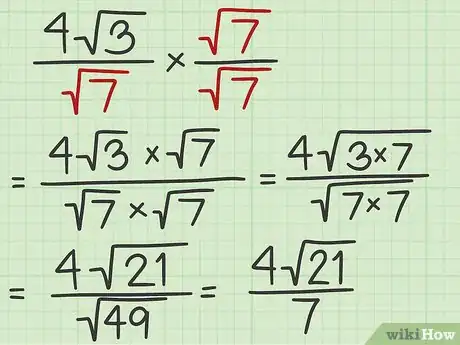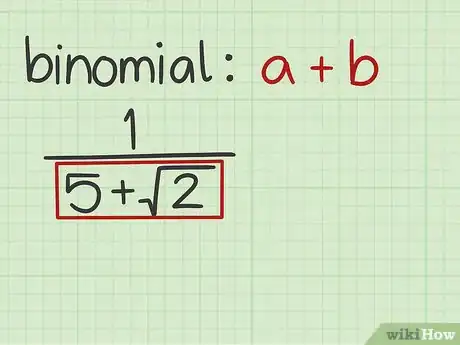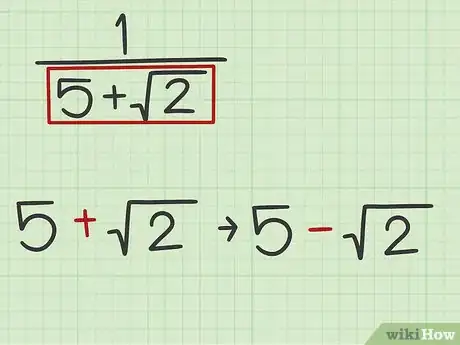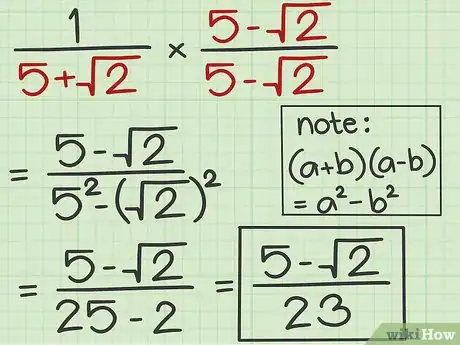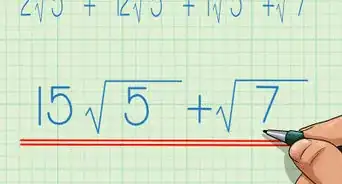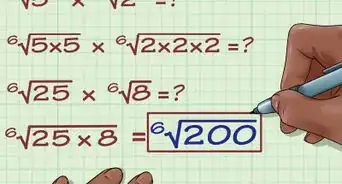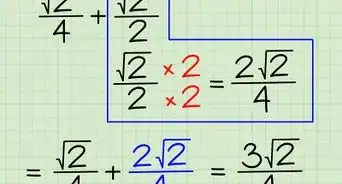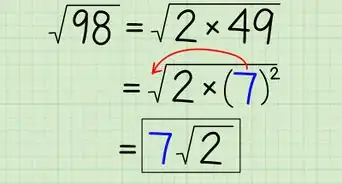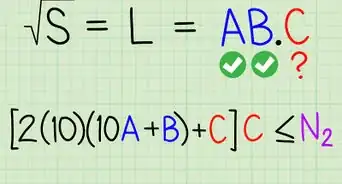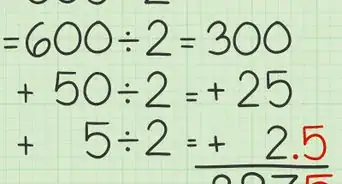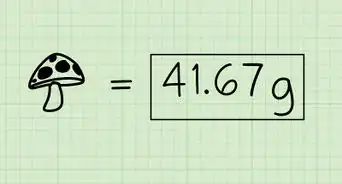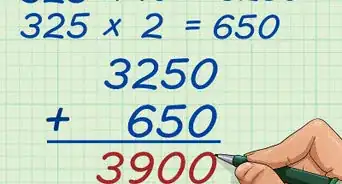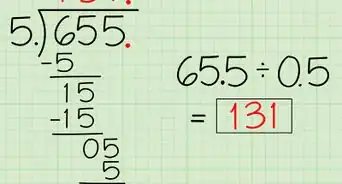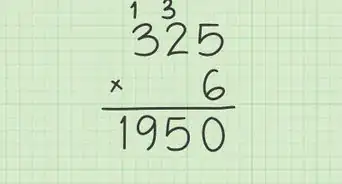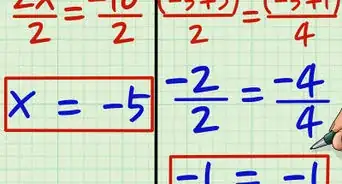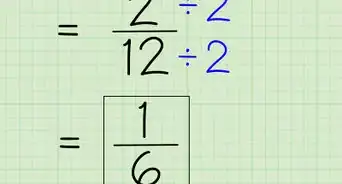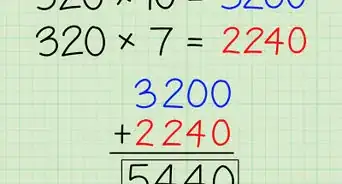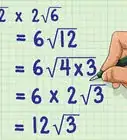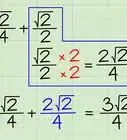This article was co-authored by David Jia. David Jia is an Academic Tutor and the Founder of LA Math Tutoring, a private tutoring company based in Los Angeles, California. With over 10 years of teaching experience, David works with students of all ages and grades in various subjects, as well as college admissions counseling and test preparation for the SAT, ACT, ISEE, and more. After attaining a perfect 800 math score and a 690 English score on the SAT, David was awarded the Dickinson Scholarship from the University of Miami, where he graduated with a Bachelor’s degree in Business Administration. Additionally, David has worked as an instructor for online videos for textbook companies such as Larson Texts, Big Ideas Learning, and Big Ideas Math.
There are 10 references cited in this article, which can be found at the bottom of the page.
This article has been viewed 630,527 times.
Dividing square roots is essentially simplifying a fraction. Of course, the presence of square roots makes the process a little more complicated, but certain rules allow us to work with fractions in a relatively simple way. The key thing to remember is that you must divide coefficients by coefficients, and radicands by radicands. You can also never have a square root in a denominator.
Steps
Dividing Radicands
-
1Set up a fraction. If your expression is not already set up like a fraction, rewrite it this way. This makes it easier to follow all the necessary steps when dividing by a square root. Remember that a fraction bar is also a division bar.[1]
- For example, if you are calculating , rewrite the problem like this: .
-
2Use one radical sign. If your problem has a square root in the numerator and denominator, you can place both radicands under one radical sign.[2] (A radicand is a number under a radical, or square root, sign.) This will simplify the simplifying process.
- For example, can be rewritten as .
Advertisement -
3Divide the radicands. Divide the numbers as you would any whole number. Make sure to place their quotient under a new radical sign.[3]
- For example, , so .
-
4Simplify, if necessary. If the radicand is a perfect square, or if one of its factors is a perfect square, you need to simplify the expression. A perfect square is the product of a whole number multiplied by itself.[4] For example, 25 is a perfect square, since .
- For example, 4 is a perfect square, since . Thus:
So, .
- For example, 4 is a perfect square, since . Thus:
Factoring Radicands
-
1Express the problem as a fraction. You will likely already see the expression written this way. If not, change it. Solving the problem as a fraction makes it easier to follow all the necessary steps, especially when factoring the square roots. Recall that a fraction bar is also a division bar.[5]
- For example, if you are calculating , rewrite the problem like this: .
-
2
-
3Simplify the numerator and denominator of the fraction. To simplify a square root, pull out any factors that make a perfect square. A perfect square is the result of a whole number multiplied by itself.[7] The factor will now become a coefficient outside of the square root.
- For example:
So,
- For example:
-
4Rationalize the denominator, if necessary. As a rule, an expression cannot have a square root in the denominator. If your fraction has a square root in the denominator, you need to rationalize it. This means to cancel out the square root in the denominator. To do this, multiply the numerator and denominator of the fraction by the square root you need to cancel.[8]
- For example, if your expression is , you need to multiply the numerator and denominator by to cancel the square root in the denominator:
.
- For example, if your expression is , you need to multiply the numerator and denominator by to cancel the square root in the denominator:
-
5
Dividing Square Roots with Coefficients
-
1Simplify the coefficients. These are the numbers outside of the radical sign. To simplify them, divide or reduce, ignoring the square roots for now.[10]
- For example, if you are calculating , you would first simplify . The numerator and denominator can both be divided by a factor of 2. So, you can reduce: .
-
2Simplify the square roots. If the numerator is evenly divisible by the denominator, simply divide the radicands. If not, simplify each square root as you would any square root.[11]
- For example, since 32 is evenly divisible by 16, you can divide the square roots:.
-
3Multiply the simplified coefficient(s) by the simplified square root. Remember that you cannot have a square root in a denominator, so when multiplying a fraction by a square root, place the square root in the numerator.[12]
- For example, .
-
4Cancel the square root in the denominator, if necessary. This is called rationalizing the denominator. As a rule, an expression cannot have a square root in the denominator. To rationalize the denominator, multiply the numerator and denominator by the square root you need to cancel.[13]
- For example, if your expression is , you need to multiply the numerator and denominator by to cancel the square root in the denominator:
- For example, if your expression is , you need to multiply the numerator and denominator by to cancel the square root in the denominator:
Dividing by a Binomial with a Square Root
-
1Determine that you have a binomial in the denominator. The denominator will be the number in the problem you are dividing by. A binomial is a two-termed polynomial.[14] This method only applies to division of square roots involving a binomial.
- For example, if you are calculating , you have a binomial in the denominator, since is a two-termed polynomial.
-
2Find the conjugate of the binomial. Conjugate pairs are binomials that have the same terms, but opposite operations.[15] Using a conjugate pair will allow you to cancel the square root in the denominator.
- For example, and are conjugate pairs, since they have the same terms but opposite operations.
-
3Multiply the numerator and denominator by the denominator’s conjugate. Doing this will allow you to cancel the square root, because the product of a conjugate pair is the difference of the square of each term in the binomial.[16] That is, .
- For example:
Thus, .
- For example:
Community Q&A
-
QuestionHow can I divide root 5 by 5?
 DonaganTop Answerer√5 / 5 cannot be rationalized, simplified, or reduced. All you could do is to divide √5 (2.236) by 5.
DonaganTop Answerer√5 / 5 cannot be rationalized, simplified, or reduced. All you could do is to divide √5 (2.236) by 5. -
QuestionHow can divide 1 by sqrt*2?
 Community AnswerYou need to rationalize the denominator, since a denominator cannot have a square root. To do this, multiply the numerator and the denominator by sqrt*2: 1 x sqrt*2 = sqrt*2 sqrt*2 x sqrt*2 = 2. So it simplifies to sqrt*2/2.
Community AnswerYou need to rationalize the denominator, since a denominator cannot have a square root. To do this, multiply the numerator and the denominator by sqrt*2: 1 x sqrt*2 = sqrt*2 sqrt*2 x sqrt*2 = 2. So it simplifies to sqrt*2/2. -
QuestionHow do I divide root3/root3?
 DonaganTop AnswererAnything (other than zero) divided by itself is 1.
DonaganTop AnswererAnything (other than zero) divided by itself is 1.
Warnings
- Never leave a radical in the denominator of a fraction, but instead simplify or rationalize it.⧼thumbs_response⧽
- Never put or leave a decimal or a mixed number in front of a radical, but instead change either to a fraction and simplify the entire expression.⧼thumbs_response⧽
- Never put a decimal into a fraction. That would be a fraction within a fraction.⧼thumbs_response⧽
- If your denominator includes any kind of addition or subtraction, then use a conjugate pair method to remove radical from the denominator.⧼thumbs_response⧽
References
- ↑ https://flexbooks.ck12.org/cbook/ck-12-algebra-ii-with-trigonometry-concepts/section/5.6/primary/lesson/dividing-square-roots-alg-ii/
- ↑ https://flexbooks.ck12.org/cbook/ck-12-algebra-ii-with-trigonometry-concepts/section/5.6/primary/lesson/dividing-square-roots-alg-ii/
- ↑ https://sciencing.com/how-to-divide-radicals-13712229.html
- ↑ https://flexbooks.ck12.org/cbook/ck-12-algebra-ii-with-trigonometry-concepts/section/5.6/primary/lesson/dividing-square-roots-alg-ii/
- ↑ https://openstax.org/books/elementary-algebra-2e/pages/9-5-divide-square-roots
- ↑ http://www.purplemath.com/modules/radicals4.htm
- ↑ https://openstax.org/books/elementary-algebra-2e/pages/9-5-divide-square-roots
- ↑ http://www.purplemath.com/modules/radicals5.htm
- ↑ https://openstax.org/books/elementary-algebra-2e/pages/9-5-divide-square-roots
- ↑ https://www.youtube.com/watch?v=RXMM6bbvA_g
- ↑ https://www.khanacademy.org/math/algebra/x2f8bb11595b61c86:rational-exponents-radicals/x2f8bb11595b61c86:simplifying-square-roots/a/simplifying-square-roots-review
- ↑ https://www.wtamu.edu/academic/anns/mps/math/mathlab/int_algebra/int_alg_tut40_addrad.htm
- ↑ http://www.purplemath.com/modules/radicals5.htm
- ↑ https://www.mathsisfun.com/definitions/binomial.html
- ↑ http://www.themathpage.com/alg/multiply-radicals.htm#conjugates
- ↑ http://www.themathpage.com/alg/multiply-radicals.htm#conjugates
About This Article
To divide square roots using radicands, set up the expression as a fraction using one radical sign. If your problem has a square root in the numerator and denominator, you can place both radicands under one radical sign. Then, divide the radicands just as you would whole numbers, making sure to place the radicand quotient under a new radical sign. If the radicand is a perfect square, or if one of its factors is a perfect square, simplify the expression to finalize your answer! To learn how to divide square roots by using coefficients, read on!
